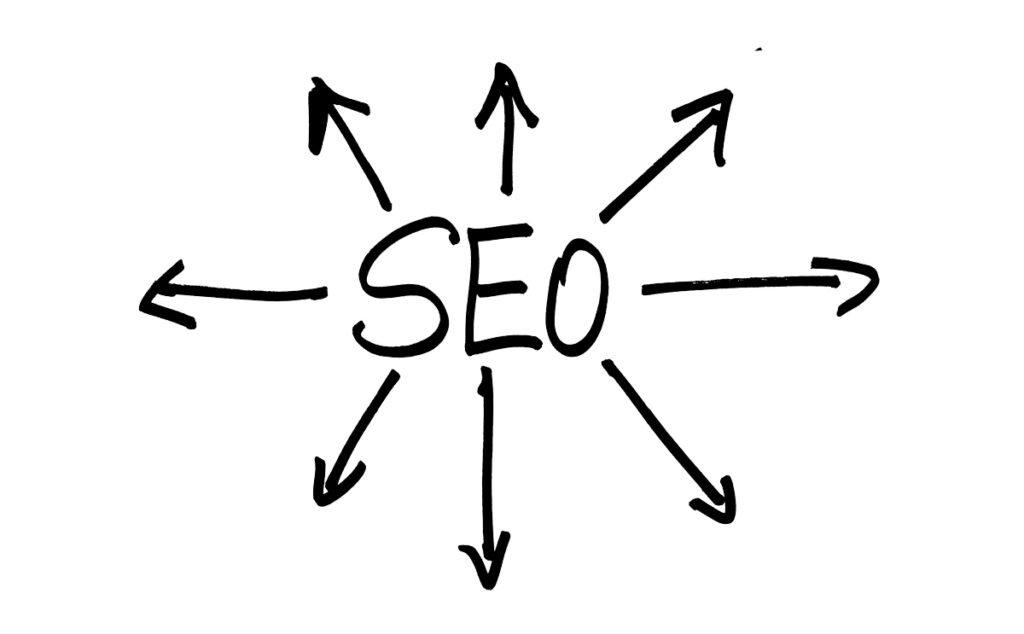Are you tired of feeling like your website is being left out in the digital abyss with no traffic from search engines? Let’s dive into the quirky world of website traffic and why your site may not be getting traffic from search engines, and how it reminds me of all those socially awkward encounters at get-togethers.
1. Neglected SEO Basics: Showing Up Empty Handed
You are not a kitchen person so you don’t make anything for the potluck dinner… but you show up and eat everyone else’s goodness including Jan’s cheesie potatoes and Suzie’s creamy cheesecake. Notice how everyone at the table is raving about Jan and Suzie…. they are now on the map! Similarly, using SEO settings will help get you noticed, while neglecting them can leave your website unnoticed.
Often I see SEO settings not being used optimally – either the fields are blank or they have no keyword in them. This leaves it up to the Google Bot to figure out not just who you are, and what you offer/sell. That doesn’t lean in your favor when that happens. The missing elements I see often are:
1. Missing SEO Titles: this is the title of the page that shows up in a Google Search result
2. Missing meta description: this is the body of the page that appears in the Google Search result
3. None or Poor keyword optimization: there should be one primary keyword per page, should not be repeated across other pages or it will conflict/cannibalize, and the keyword should be strategically placed in all proper fields for that page.
4. Lack of quality content using said keywords: be sure to use it not only in headlines but also body content and blog posts.
5. Not using an H1 tag (headline tag) per page. Often I see either none or too many h1 tags on a page, and if the H1 tag does exist often it does not contain the relevant keyword for that page.
2. Slow Page Speed: Being Fashionably Late
Imagine saying Hi to someone for the first time in person, and they take forever to respond back. Or worse, showing up late to my dad’s party and missing out on his kickass fajitas and Jenn’s killer margaritas – AND everyone is 5 deep and having ‘I love you man’ moments… Well, page speed that’s late loading can affect your website from even being preferred by Google and Bing and it can also leave an unsavory impression by the customer. There should be a good importance placed on page speed and where there is room to technically optimize it – go for it! From image compression to caching, we can help your website sprint ahead of the competition.
One of the top ways to improve page speed is to compress images – optimize them for the Web. This can be remedied in Photoshop and there are also free and paid Plugins if your site is on WordPress. Large image file sizes take up more bandwidth and require more data to load, leading to longer load times. By reducing the file size of images through compression, a website can significantly reduce the amount of data required for image files, resulting in faster load times. There are many tools available online that can help with image compression such as TinyPNG, Compressor.io, and Optimizilla. Additionally, some content management systems such as WordPress offer plugins that handle image compression automatically.
Caching is also an effective way to improve page speed. When someone visits a website, the site’s files are downloaded and loaded into their browser cache. The next time they visits the website, the cached files are used instead of being downloaded again. This process can significantly reduce page load times for repeat visitors. Caching can be implemented at different levels of a website, including the server, the browser, or through a content delivery network (CDN). Google recommends that websites implement server-side caching for optimal performance.
Another way to improve page speed is to optimize code. Scripts that are not optimized, such as large or no longer needed javascript or CSS files, can slow down a website’s load times. Minifying these files, or removing unnecessary code such as spaces or comments, can significantly decrease file size and improve page speed. If your site is on WordPress there are free and paid plugins that can help with this.
3. Unresponsive Design: The Awkward Conversation Partner
Have you ever tried to engage in a conversation with someone who seemed disinterested or unresponsive? That’s how visitors feel on a website with an unresponsive design – alienating. By ensuring a responsive design experience, your website will provide a positive experience across various devices, eliminating the need for the reader to zoom, scroll excessively, or deal with unreadable text. Below I get into the importance of mobile-friendly websites and provide insights on creating a seamless user experience across devices:
In today’s digital age, having a mobile-friendly website is no longer an option – it’s a necessity. Over 50% of website viewers are on a mobile device. Some people don’t even have use for a desktop computer anymore. Therefore, it is crucial for businesses to prioritize mobile responsiveness and provide a seamless user experience across devices.
Since mobile usage has surpassed desktop usage – these people rely on their phones and your responsive design for quick access to information, entertainment, and online shopping. A non-responsive website with having to read any tiny text, and hard-to-navigate menus will frustrate mobile visitors and drive them away. On the other hand, a mobile-friendly website ensures that readers can easily access and navigate, improving engagement and increasing the likelihood of conversions.
Search engines like Google prioritize mobile-friendly websites in their search rankings. If your website lacks mobile optimization, it will be outranked by competitors who have invested in responsive design. This can have a detrimental effect on your organic search traffic and visibility. By embracing mobile responsiveness, you can improve your chances of being discovered.
Navigation is another crucial part of a seamless mobile visitor experience. On mobile devices, screen real estate is limited, so it’s important to simplify and streamline your navigation menu. Use a hamburger menu icon that expands into a vertical or horizontal menu when clicked, allowing readers to easily access different sections of your site. Additionally, ensure that buttons and links are appropriately sized and spaced to prevent accidental taps or clicks.
Fast page load speeds are vital for mobile visitors who may have limited data plans and minimal patience for slow-loading websites. Optimize your website’s performance by minimizing the size of image files, pick a host that has reduced server response time, and leverage browser caching (a plugin on your site or a standard feature at your host).
Content plays a crucial role in providing a seamless user experience across devices. Prioritize the most relevant and essential information within the first scrolls and what your website copy actually says/offers, and ensure that it is easily accessible and readable on smaller screens. Consider breaking up long paragraphs into shorter, scannable sections, use bullet points, and incorporating visual elements like iconography to make the site easy on the eyes. Strive for a balance between providing valuable content and keeping it concise and digestible for mobile visitors. If you say “I” too much and talk about yourself a lot, consider trimming some of that down and instead focus on what the benefits are of the service.
4. Lack of Quality Backlinks: The Social Butterfly Effect
Just like meeting someone through mutual connections can boost your credibility and trust, having quality backlinks can enhance your website’s visibility.
Backlinks are one of the components of successful search engine optimization (SEO) efforts. If you are looking to improve your site’s ranking in search engine results pages (SERPs), then building quality backlinks is something to add to the mix.
Backlinks are a critical component of a successful SEO strategy because they are a signal that search engines use to determine the relevance and ‘authority’ of a website. When a website links to yours, it is essentially vouching for your content and telling search engines that your site is worth visiting. Search engines view high-quality backlinks as an indicator of a site’s credibility and authority, which can have a positive impact on its ranking in SERPs. However, be mindful of paid backlinks. Google recognizes certain practices like too many of the same IP address backlinking to your site, and this can actually repel google and lower your SEO score.
One way to build backlinks is to engage in guest posting. Guest posting involves publishing original content on another website or blog within your industry or niche, usually in exchange for a backlink to your site (ie in the Author bio or within hyperlinks on the article itself). When you write a guest post, it is important to focus on creating high-quality, original content that provides value to the website’s readers. I’ve even added my feedback to a Divi Developer forum which had a field for my business website. By entering that into my comment I started seeing it listed as a backlink to my site. Pretty neat!
In addition to guest posting, partnerships/collaborations can also be an effective way to build quality backlinks. Collaborating with other professionals that may be alongside your niche or have an audience that is interested in your offering or industry can help you reach a wider audience and build relationships with other businesses and content creators. This can lead to opportunities for guest posting, as well as other forms of collaboration, such as social media promotion and co-branded content.
It is also essential to maintain a diverse backlink profile. This means that you should aim to have backlinks from a variety of different sources (different IP addresses is what Google looks for), including blogs, social media profiles, and industry associations. By diversifying your backlink profile, you can ensure that your site appears more credible and authoritative in the eyes of search engines.
When it comes to the impact that backlinks can have on your website’s SEO, according to a study by Ahrefs, the number of websites linking to your site is a strong predictor of a site’s ranking in SERPs. The study found that sites with a high number of referring domains tended to rank higher than those with fewer referring domains.
In addition to the number of referring domains, the quality of the backlinks is also important. Backlinks from high-authority websites are more valuable than those from low-authority sites. According to Moz, high-quality backlinks can have a significant impact on a site’s ranking in SERPs. In fact, sites with high-quality backlinks tend to rank higher than those with a large number of low-quality backlinks.
5. Thin or Irrelevant Content: Getting Cornered By Someone Who Only Talks About Themselves
Ever been stuck in a conversation with someone who only talks about themselves without considering your interests? Thin or irrelevant content can have a similar effect on your website’s traffic. Below I get into the importance of valuable and engaging content that resonates with your target audience.
In today’s crowded digital landscape, businesses and content creators compete for the attention of their audience. The best way to cut through the noise is to create content that adds value, informs, entertains, or inspires your target audience.
First and foremost, creating relevant content that resonates with your target audience can help you build trust and credibility. When you provide content that is helpful and informative, you demonstrate your expertise in your field and show your audience that you care about their needs and interests. This can help you build a loyal following of readers or customers who trust your brand and are more likely to do business with you in the future.
Creating valuable and engaging content can also help you increase engagement and shareability. When your audience finds your content interesting and informative, they are more likely to engage with it by liking, commenting, or sharing it with others. This can help you increase your reach and visibility on social media and other digital platforms.
Another benefit of creating relevant content that resonates with your target audience is that it can help you establish your brand’s voice and tone. You can differentiate yourself from your competitors and build a strong brand identity.
Moreover, valuable and engaging content can lead to conversions. For example, if you create content that educates your audience about your product or service, you can help them better understand its value and benefits, which can ultimately lead to increased sales. Additionally, valuable and engaging content can help you build an email or subscriber list, which can be used for further marketing efforts.
To create content that resonates with your audience, it is important to start by understanding their needs and interests. Conducting market research and audience analysis can help you gain a deeper understanding of what your audience wants and needs. You can use this information to create content that speaks directly to your audience, addresses their pain points, and offers solutions to their problems.
Lastly, creating relevant content requires an understanding of your audience’s preferences and consuming habits. Some audiences prefer written content, while others prefer video or interactive content. By creating different types of content that match your target audience’s preferences, you can create a more engaging experience that resonates with them.
By following these examples and solutions as to why your website isn’t getting any traffic from search engines, you can break free from the digital abyss and start attracting more visitors with confidence.
If you are wondering if your site is using SEoO fields optimally, is anyone is finding your site organically, or would like a website review – please reach out!




